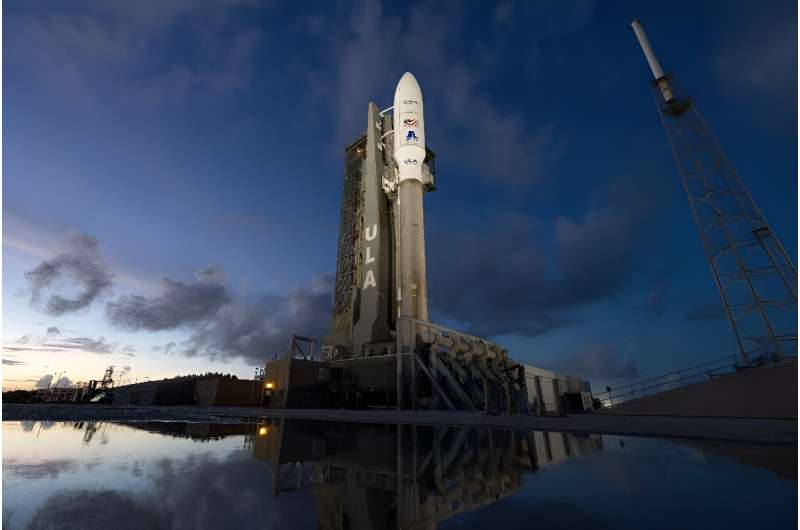
Copernical Team
Guide stars found as Euclid's navigation is fine tuned

Euclid has found its "lost" guide stars as a software patch has solved its navigation woes and the next six years of observation schedules have been redesigned to avoid stray sunlight: it's the end of an interesting commissioning phase and Euclid will now undergo its final testing in full "science mode.
Hypergravity odyssey of Earth's tiniest plant

The smallest flowering plant on Earth might become a nutritious foodstuff for astronauts in the future, as well as a highly efficient source of oxygen. To help test their suitability for space, floating clumps of watermeal—individually the size of pinheads—were subjected to 20 times normal Earth gravity aboard ESA's Large Diameter Centrifuge by a team from Mahidol University in Thailand.
Based at ESA's ESTEC technical center in the Netherlands, the LDC is an 8-m-diameter, four-arm centrifuge that gives researchers access to a range of hypergravity up to 20 times Earth gravity for weeks or months at a time.
Access to the LDC was arranged through HyperGES, part of the Access to Space for All initiative sponsored by ESA and the United Nations Office of Outer Space Affairs, UNOOSA.
Amazon's challenge to Musk's Starlink to have first launch

Amazon is set to launch two satellites on Friday, in its first test mission as part of its plan to deliver the internet from space and compete with Elon Musk's Starlink service.
The launch window for the Atlas V rocket from the United Launch Alliance (ULA) hub at Kennedy Space Center in Florida is scheduled to open for two hours at 2:00 pm local time (1800 GMT).
Once up and running, the company founded by Jeff Bezos says its Project Kuiper will provide "fast, affordable broadband to unserved and underserved communities around the world," with a constellation of more than 3,200 satellites in low Earth orbit (LEO).
Amazon's Project Kuiper takes flight with first satellite launch
 Amazon's expansive ambitions to delve into satellite-based broadband have taken a concrete form. On October 6, 2023, the e-commerce behemoth successfully launched KuiperSat-1 and KuiperSat-2, the initial pair of its projected constellation of more than 3,200 satellites. The launch, executed from Launch Pad 41 at Cape Canaveral Space Force Station, utilized the reliable United Launch Alliance Atl
Amazon's expansive ambitions to delve into satellite-based broadband have taken a concrete form. On October 6, 2023, the e-commerce behemoth successfully launched KuiperSat-1 and KuiperSat-2, the initial pair of its projected constellation of more than 3,200 satellites. The launch, executed from Launch Pad 41 at Cape Canaveral Space Force Station, utilized the reliable United Launch Alliance Atl ESA and Axiom Space forge partnership for future space exploration

The European Space Agency ESA and Axiom Space signed a Memorandum of Understanding on 1 October in Paris to explore collaborative opportunities in human spaceflight, science, technology, and commercialisation.
Superconductivity at room temperature remains elusive
 by David D. Nolte | Professor - Physics and Astronomy, Purdue
On April 8, 1911, Dutch physicist Heike Kamerlingh Onnes scribbled in pencil an almost unintelligible note into a kitchen notebook: "near enough null."
The note referred to the electrical resistance he'd measured during a landmark experiment that would later be credited as the discovery of superconductivity. But first, he
by David D. Nolte | Professor - Physics and Astronomy, Purdue
On April 8, 1911, Dutch physicist Heike Kamerlingh Onnes scribbled in pencil an almost unintelligible note into a kitchen notebook: "near enough null."
The note referred to the electrical resistance he'd measured during a landmark experiment that would later be credited as the discovery of superconductivity. But first, he Instant evolution: AI designs new robot from scratch in seconds
 A team led by Northwestern University researchers has developed the first artificial intelligence (AI) to date that can intelligently design robots from scratch.
To test the new AI, the researchers gave the system a simple prompt: Design a robot that can walk across a flat surface. While it took nature billions of years to evolve the first walking species, the new algorithm compressed evol
A team led by Northwestern University researchers has developed the first artificial intelligence (AI) to date that can intelligently design robots from scratch.
To test the new AI, the researchers gave the system a simple prompt: Design a robot that can walk across a flat surface. While it took nature billions of years to evolve the first walking species, the new algorithm compressed evol Last September was hottest on record by 'extraordinary' margin: EU monitor
 Last month was the hottest September on record by an "extraordinary" margin as the world flirts dangerously with breaching a key warming limit, the EU climate monitor said on Thursday.
Much of the world sweltered through unseasonably warm weather in September, in a year expected to be the hottest in human history and after the warmest-ever global temperatures during the Northern Hemisphere s
Last month was the hottest September on record by an "extraordinary" margin as the world flirts dangerously with breaching a key warming limit, the EU climate monitor said on Thursday.
Much of the world sweltered through unseasonably warm weather in September, in a year expected to be the hottest in human history and after the warmest-ever global temperatures during the Northern Hemisphere s CfA-SwRI heliophysics mission selected for Phase A mission definition study
 NASA has selected a new SwRI-managed heliophysics mission focused on investigating the Sun's middle corona - an enigmatic region of the Sun's atmosphere driving solar activity - for a Phase A, mission definition study. Southwest Research Institute's Dr. Dan Seaton is deputy principal investigator of the Center for Astrophysics | Harvard and Smithsonian-led EUV CME and Coronal Connectivity Observ
NASA has selected a new SwRI-managed heliophysics mission focused on investigating the Sun's middle corona - an enigmatic region of the Sun's atmosphere driving solar activity - for a Phase A, mission definition study. Southwest Research Institute's Dr. Dan Seaton is deputy principal investigator of the Center for Astrophysics | Harvard and Smithsonian-led EUV CME and Coronal Connectivity Observ Does lightning strike on Venus? Maybe not, study suggests
 Venus may be a (slightly) gentler place than some scientists give it credit for.
In new research, space physicists at the University of Colorado Boulder have jumped into a surprisingly long-running debate in solar system science: Does lightning strike on the second planet from the sun?
The team's results add strong new evidence suggesting that, no, you probably wouldn't see bolts of
Venus may be a (slightly) gentler place than some scientists give it credit for.
In new research, space physicists at the University of Colorado Boulder have jumped into a surprisingly long-running debate in solar system science: Does lightning strike on the second planet from the sun?
The team's results add strong new evidence suggesting that, no, you probably wouldn't see bolts of 
